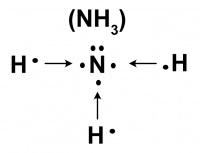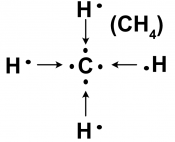Difference between revisions of "Ch10 Lec 1"
| (5 intermediate revisions by the same user not shown) | |||
| Line 44: | Line 44: | ||
===Other molecular structures=== | ===Other molecular structures=== | ||
So there are a few other molecular structures that you are aware of but never really questioned. | So there are a few other molecular structures that you are aware of but never really questioned. | ||
| − | :Ammonia (NH<sub>3</sub>) | + | :'''Ammonia''' (NH<sub>3</sub>) |
| − | [[File:Screen Shot 2020-05-06 at 7.40.00 AM.png| | + | {| |
| + | |[[File:Screen Shot 2020-05-06 at 7.40.00 AM.png|200px]]|| ----> ||[[File:Screen Shot 2020-05-06 at 7.47.10 AM.png|250px]] | ||
| + | |} | ||
| + | :- where the "-" is a shorthand notation for a pair of electrons...ie a covalent bond. | ||
| + | :- Notice also that NH<sub>3</sub> has a "lone pair" of electrons that are not involved in any bonding relationship. | ||
| − | [[File:Screen Shot 2020-05-06 at 7. | + | :'''Methane''' (CH<sub>4</sub>) |
| + | {| | ||
| + | |[[File:Screen Shot 2020-05-06 at 7.54.43 AM.png|175px]]|| ---->||[[File:Screen Shot 2020-05-06 at 7.55.51 AM.png|200px]] | ||
| + | |} | ||
| − | : | + | :'''Water''' |
| + | {| | ||
| + | |[[File:Screen Shot 2020-05-06 at 8.00.21 AM.png|200px]]|| ---->||[[File:Screen Shot 2020-05-06 at 8.01.01 AM.png|200px]] | ||
| + | |} | ||
| + | :- Notice that H<sub>2</sub>O has 2 "lone pairs" of electrons...this molecular arrangement results in water having many interesting properties. | ||
| + | |||
| + | END of Lecture/term. | ||
Latest revision as of 13:04, 6 May 2020
(5/6/20, bes)
Welcome to the last Gen Chem lecture for the spring 2020 term. This is been quite an exercise in flexibility. We have covered almost all the topics usually covered, but we have not done them in as much detail as we would have if we met in person. We certainly did a few more WA!
The final exam for this class is scheduled for Weds, May 13th at 8 am. This will be given via WA and similar instruction will apply. I will send an email later with more details.
Covalent Bond (Sec 9.4)
In our previous lecture on ionic bonds, we discussed how elements like to have the "stable" electron configuration of the noble gases. In the case of ionic bonding, elements gain or lose an electron to attain this electron configuration, hence resulting in anions and cations that are electrostatically attracted to each other.
In a covalent bond, elements engage in a "sharing" relationship in order to attain the noble gas electron configuration. For example, we have known for a long time that there are diatomic elements in the periodic table...H2, N2, O2, all halogens like Cl2...why?
- Hydrogen atoms have only 1 electron, so if 2 H-atoms share the 2 electrons, then,
When we draw the electrons as "dots" we refer to these as Lewis Structures. If we were to draw the Lewis structure for neon (Ne) it would look like this: ![]() , where the 8 electrons shown represent the full 2s and 2p orbitals...and the Lewis structures do not show the 1s electrons. This requires some new vocabulary:
, where the 8 electrons shown represent the full 2s and 2p orbitals...and the Lewis structures do not show the 1s electrons. This requires some new vocabulary:
- - the electrons in lower/inner shells, like the 1s electrons in Ne are called core electrons.
- - the electrons in higher/outer shells, like the 2s and 2p electrons in Ne are called valence electrons.
- - Lewis structures show only valence electrons.
"The chemistry/reactivity/behavior of elements is dictated by the valence electrons and not the core electrons.
- Nitrogen atoms have 7 total electrons, 2- 1s core electrons, and 5- 2s/2p valence electrons, so the Lewis structure for a N-atom is
 and so if an N-atom is going to have an electron configuration of a noble gas (Ne), then it must share 3 electrons with another N-atom:
and so if an N-atom is going to have an electron configuration of a noble gas (Ne), then it must share 3 electrons with another N-atom:
- - Nitrogen gas has a triple bond making it one of the most stable gases on our planet!
- Oxygen atoms have 8 total electrons, 2- 1s core electrons, and 6- 2s/2p valence electrons, so the Lewis structure for an O-atom is
 and so if an O-atom is going to have an electron configuration of a noble gas (Ne), then it must share 2 electrons with another O-atom:
and so if an O-atom is going to have an electron configuration of a noble gas (Ne), then it must share 2 electrons with another O-atom:
- - Oxygen gas has a double bond making it one of the most stable gases on our planet!
- Chlorine atoms have 17 total electrons, 8- 1s/2s/2p core electrons, and 7- 3s/3p valence electrons, so the Lewis structure for a Cl-atom is
 and so if an Cl-atom is going to have an electron configuration of a noble gas (Ar), then it must share 1 electron with another O-atom:
and so if an Cl-atom is going to have an electron configuration of a noble gas (Ar), then it must share 1 electron with another O-atom:
- - Chlorine gas has a single bond, that is not particularly strong hence you do not find Cl2 gas on our planet.
Other molecular structures
So there are a few other molecular structures that you are aware of but never really questioned.
- Ammonia (NH3)
 |
----> | 
|
- - where the "-" is a shorthand notation for a pair of electrons...ie a covalent bond.
- - Notice also that NH3 has a "lone pair" of electrons that are not involved in any bonding relationship.
- Methane (CH4)
 |
----> | 
|
- Water
 |
----> |
- - Notice that H2O has 2 "lone pairs" of electrons...this molecular arrangement results in water having many interesting properties.
END of Lecture/term.



